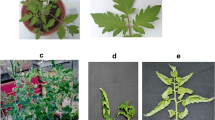Abstract
The complete genomic sequences of two distinct Beet western yellows virus (BWYV) genotypes infecting sugar beet in Bei**g, named as BWYV-BJA and BWYV-BJB (GenBank accession number HM804471, HM804472, respectively), were determined by RT-PCR sub-cloning approach. BWYV-BJA and BWYV-BJB were 5674 and 5626nt in length, respectively. BWYV-BJB was 48nt shorter than BWYV-BJA in the regions 1589–1615 and 1629–1649nt. Sequence alignment analysis showed that the full length of BWYV-BJA and BWYV-BJB shared 93% nucleotide sequence identity, with relatively high variability within ORFs 0, 1, 2 (at the nucleotide level was 86.3–88.8%) and high conservation within ORFs 3, 4, 5 (at the nucleotide level was 99.3–99.5%). The complete nucleotide sequences of BWYV-BJA and BWYV-BJB were most related to BWYV-US (80.6 and 79.0%, respectively). ORFs 1, 2 of BWYV-BJA and BWYV-BJB shared the highest homology with BWYV-US (nucleotide identity 91.2–93.3, 86.7–89.5%, respectively) and their ORFs 3, 4 were more closely related to BWYV-IM. However, their ORF5 were more closely related to that of Cucurbit aphid-borne yellows virus China strain (CABYV-CHN), with 68.1 and 68.5% nucleotide identity, respectively. Based on the sequence and phylogenetic analysis, we proposed that BWYV-BJ was at least a novel strain of BWYV, and BWYV-BJA, BWYV-BJB were two distinct genotypes of BWYV-BJ. In addition, phylogenetic analysis and recombination analysis suggested that BWYV-BJA and BWYV-BJB might be recombinant viruses.




Similar content being viewed by others
References
S. Gray, F.E. Gildow, Annu. Rev. Phytopathol. 41, 539–566 (2003)
J.E. Duffus, Phytopathology 50, 389–394 (1960)
J.E. Duffus, Phytopathology 51, 605–607 (1961)
M. Beuve, M. Stevens, H. Liu, W. Wintermantel, S. Hauser, O. Lemaire, Plant Dis. 92, 51–60 (2008)
S. Marco, Plant Dis. 68, 162–163 (1984)
H. **ang, S. Dong, H. Zhang, W. Wang, M. Li, C. Han, D. Li, J. Yu, Virus Genes 41, 105–110 (2010)
C. Liu, **njiang agricultural science and technology. 4, 41 (2009)
M. Stevens, B. Freeman, H. Liu, E. Herrbach, O. Lemarie, Mol. Plant Pathol. 6, 1–9 (2005)
S. Pfeffer, P. Dunoyer, F. Heim, K.E. Richards, G. Jonard, V. Ziegler-Graff, J. Virol. 76, 6815–6824 (2002)
F. van der Wilk, M. Verbeek, A.M. Dullemans, J.F.J.M. van den Heuvel, Virology 234, 300–303 (1997)
M.A. Mayo, V. Ziegler-Graff, Adv. Virus Res. 56, 413–460 (1996)
M. Pazhouhandeh, The mechanism of action of Polerovirus P0 in RNA silencing suppression (Ulp Publishing eprints-scd-ulp.u-strasbg) (2007), http://eprints-scd-ulp.u-strasbg.fr:8080/802/01/pazhouhandeh2007.pdf. Accessed 6 Sep 2007
K. Peter, F. Gildow, P. Palukaitis, S. Gray, J. Virol. 83, 5419–5429 (2009)
C. Han, D. Li, Y. **ng, K. Zhu, Z. Tian, Z. Cai, J. Yu, Y. Liu, Plant Dis. 84, 627–630 (2000)
T.A. Hall, Nucl. Acid Symp. Ser. 41, 95–98 (1999)
J. Thompson, D. Higgins, T. Gibson, Nucl. Acids Res. 22, 4673–4680 (1994)
S. Kumar, M. Nei, J. Dudley, K. Tamura, Brief Bioinform. 9, 299–306 (2008)
D. Martin, C. Williamson, D. Posada, Bioinformatics 21, 260–262 (2005)
M. Lai, Microbiol. Mol. Biol. R. 56, 61 (1992)
P. Nagy, A. Simon, Virology 235, 1–9 (1997)
R. Froissart, D. Roze, M. Uzest, L. Galibert, S. Blanc, Y. Michalakis, PLoS Biol. 3, e89 (2005)
R. Aaziz, M. Tepfer, J. Gen. Virol. 80, 1339 (1999)
M. Worobey, E. Holmes, J. Gen. Virol. 80, 2535 (1999)
P. Nagy, in Plant Virus Evolution, ed. by M.J. Roossinck (Springer, Berlin, 2008), pp. 133–156
F. Escriu, A. Fraile, F. Garcia-Arenal, Evol. Int. J. Org. Evol. 57, 755–765 (2003)
F. Garcia-Arenal, A. Fraile, J.M. Malpica, Int. Microbiol. 6, 225–232 (2003)
L. Domier, N. McCoppin, R. Larsen, C. D’Arcy, J. Gen. Virol. 83, 1791 (2002)
M. Mayo, W. Miller, in The Luteoviridae, ed. by H.G. Smith, H. Barker (CAB International, UK, 1999)
F. Moonan, J. Molina, T. Mirkov, Virology 269, 156–171 (2000)
G. Stuart, P. Moffett, R. Bozarth, Arch. Virol. 151, 1159–1177 (2006)
F. Moonan, T. Mirkov, J. Virol. 76, 1339 (2002)
C. Fauquet, M. Mayo, J. Maniloff, U. Desselberger, L. Ball, Virus taxonomy: eighth report of the International Committee on Taxonomy of Viruses, 1st edn. (Elsevier academic press, London, 2005), pp. 891–900
Acknowledgments
This work was partially supported by Special Fund for Agro-scientific Research in the Public Interest (200903004-03), the Fund for Modern Sugarbeet-industry Technology Research System (nycytx-25-07) and the Natural Science Foundation of China (31071663).
Author information
Authors and Affiliations
Corresponding author
Additional information
Cui-Ji Zhou and Hai-Ying **ang contributed equally to this study.
Rights and permissions
About this article
Cite this article
Zhou, CJ., **ang, HY., Zhuo, T. et al. A novel strain of Beet western yellows virus infecting sugar beet with two distinct genotypes differing in the 5′-terminal half of genome. Virus Genes 42, 141–149 (2011). https://doi.org/10.1007/s11262-010-0553-9
Received:
Accepted:
Published:
Issue Date:
DOI: https://doi.org/10.1007/s11262-010-0553-9




